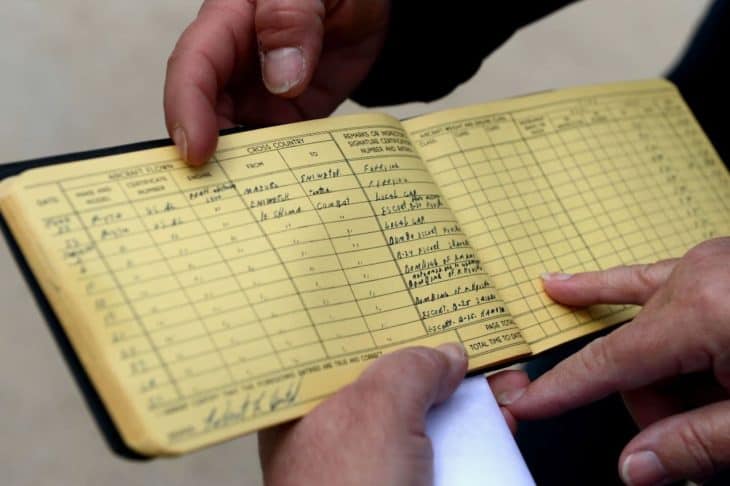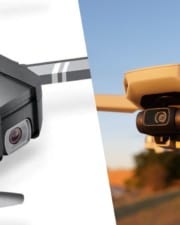Flying a plane can allow one to feel as free as a bird. Nevertheless, while our avian friends don’t have to keep logbooks, for us aviators it’s a vital practicality and legal necessity. That raises the question – how are logbooks different from one another, and which is right for you? We take a look at 9 of the best logbooks for pilots. No time to waste? We think the Jeppesen Pilot Logbook is the best!
Part of the reason for the differences in logbooks stems from the fact that the FAA does not regulate how logbooks must be laid out.
Nevertheless, whether you are seated in the left or right seat of the cockpit, are at the controls, or are otherwise involved with the mechanics of flying the plane, your time should be recorded.
As a pilot, you must always bring along your logbook with you when flying, which is one reason why small, portable logbooks are often preferred.
Table of Contents
The Best Pilot Logbooks
Let’s take a look at some of the best logbooks on the market, before we talk more about the differences in logbooks and tips on how to log flights. These are the best pilot logbooks on the market today.
1. Jeppesen Professional Pilot Logbook
This is a good example of a standard pilot logbook. It is simple and streamlined, and has pretty much everything a pilot could ask for in a basic logbook, making it a good choice for new pilots.
What’s more, it’s a choice that can last new pilots for a while, with space for ten years’ worth of flight logs.
The logbook itself features a sleek brown leather cover, embossed with gold lettering on the front. This creates a professional look. The logbook is quite professional-looking and durable. It includes space for simplified logs as well as annual summaries, allowing you to keep both basic and detailed records.
2. Jeppesen Student Pilot Logbook
- Highly Durable
- Great for the new pilot or the "weekend...
- "easy-on-the-eyes" green pages resist...
Different levels of piloting require different tools, and that’s true of logbooks as well. When you are just starting out as a flight student and still learning the ropes, you’ll want to have a logbook which is simple, straightforward, and can help you get used to logging flights.
That’s where this student pilot logbook from Jeppesen comes in. The logbook offers a simplified log layout, making it easy for new pilots to fill out logs.
The logbook itself is quite durable and features a scuff-resistant cover. The pages resist ink bleeding through, helping you to keep things nice and neat for the long haul.
3. The Standard Pilot Log (Navy Blue)
- Colorful pilot logbook optimized for FAA...
- Hardcover Book
- English (Publication Language)
Once again, the clue is in the name, as this pilot’s log is the epitome of what you can expect from a typical pilot’s logbook. It features a clean, easy to read layout, has many pages for years’ worth of logs, and is protected by a sturdy navy blue cover.
This option comes from ASA, which has long been one of the most recognizable names among flight logs. Even with flight logs themselves being somewhat unstandardized, ASA remains an unofficial industry standard.
All of these factors combine to create a logbook that is great for new as well as seasoned pilots.
4. The Standard Pilot Log (Burgundy)
- Burgundy, hard cover, 7-1/2" x 4", 206...
- Hardcover Book
- English (Publication Language)
This is another example of a standard pilot’s log. It is compact and lightweight, and can be quite useful for carrying your details around. It has more than enough room to keep detailed logs of your flights, and can be quite useful for pilots who have many in-flight aspects to log.
This is another example of a logbook which has become an unofficial industry standard over time, which adds considerably to the amount of prestige carried by the product.
When logging your flights, you want to be sure that you are doing so in a flight book that is up to snuff. The Standard Pilot Log is a standard for a reason, and it is a solid choice for both new and experienced pilots.
5. Pilot Log Book
Here we have another great example of a pilot’s logbook that goes out of its way to try to present a sense of style and sleekness. What’s more, its form perfectly complements its functionality, as this option features a hard cover and includes an elastic band for keeping the logbook closed.
The paper used for the log itself is acid-free and resists ink bleeding through, allowing you to keep neat, detailed notes on each flight you undertake.
The logbook is in keeping with FAA regulations, and includes spaces for you to record everything from certificates and flight proficiency to ratings and medical information.
6. Flight Crew Expense Log Book (Little Red Book)
- 4 ¼" X 3 ¼
- Made in USA.
The first thing that catches the eye about this logbook is the fact that it deviates significantly from the style of most others insofar as it is vertically rather than horizontally laid-out.
It looks far more like a traditional notebook, so if that is how you prefer to take notes, this may be a good logbook option to consider.
It has quite a lot of space at 216 pages, which is an impressive amount for something that’s sized so as to fit in a shirt pocket. Its vinyl cover is quite durable, and the logbook is in keeping with FAA record-keeping standards.
7. The Standard Engine Log
- Hardcover Book
- English (Publication Language)
- 96 Pages - 03/15/2013 (Publication Date)...
Few things are more important for the upkeep of your aircraft than making sure your engine is in good working order. This is vital not just for your own safety and that of everyone onboard but for your ability to be in compliance with FAA standards.
That’s why it is a good idea to keep an engine logbook such as this one on hand.
It features plenty of space to note engine inspections, the nature and result of engine tests, any repairs which may be affected, and everything else you could ever need to track the efficacy of your plane’s engines.
8. The Standard Propeller Log
- English (Publication Language)
- 20 Pages - 04/01/2000 (Publication Date)...
If you are flying a plane which makes use of propellers, you are going to need to make sure that they remain in good condition. As with engines, therefore, you are going to want to have a separate logbook on hand for keeping track of repairs, tests, and other information.
All of that is made possible by this standard propeller log.
It affords you plenty of space to log any and all vital details about the condition of your propellers, including airworthiness directives as well as factory bulletins.
The logbook itself is sleek, durable, and can be used for years.
9. Handmade Leather Cover for Pilot Logbook
If you are looking for a custom-made logbook cover, these options from Coal Creek Leather are as luxurious as they come.
When closed, these customized leather logbook covers measure 10×6.75 inches and fit the standard ASA-SP-57 Pilot Logbook shape.
Coal Creek Leather offers 16 different color options from which to choose as well as four distinct types of leather, allowing you to create a logbook which is truly unique.
The leather itself is handmade and vegetable-tanned, giving it a nice sheen. For best results, you will want to rub a bit of leather balm on the cowhide to help preserve the integrity of the cover.
It takes extra care to maintain, but the look and durability of this logbook is worth it.
What Makes a Good Pilot Logbook?
The obvious feature that every good pilot logbook must have is enough space in which to enter logs. As with passports, you need to make sure you have enough blank space to enter the appropriate details before each voyage.
A logbook that’s too small will fill up quickly and necessitate a replacement, which can be costly. Instead, buying a logbook which has enough pages to allow you to enter logs for some time is a good investment.

You’ll also want to make sure that the logs themselves are neatly arranged and spaced out so as to provide adequate room for you to log the details of each flight, including your takeoff and landing times.
If you care about style, you may also want to pay attention to the aesthetics offered on the front cover. Many logbooks come with nice leather covers or similarly sleek designs.
One of the difficulties in answering this question is that different pilots have different needs, which are in turn bound to change over time due to their experience levels.
The more experienced you are, the more likely you are to need to make detailed flight logs. That will in turn necessitate logbooks which afford you enough room to take these detailed notes.
On the other hand, at the beginning of your flight career, you are bound to want a more simple, straightforward layout.
As such, what makes for a “good pilot logbook” will differ between good student logbooks as opposed to those used by the pros.
One thing that is always bound to be of importance is durability. A logbook is necessary for all pilots to have at all times, so you do not want yours falling apart. As such, it is vital to look for logbooks which have a good reputation in terms of long-term durability.

In addition, it is important to make sure that you are getting a logbook which can remain neat and clean. You do not want to have to squint to try to read logs which feature smudged or bled-through ink.
That is why the best logbooks tend to feature paper which is specially made so as to be resistant to ink bleeding, ensuring that it is able to remain readable.
Finally, you will want to consider the size and shape of the logbook itself. While most logbooks tend to be pocket-sized and horizontal in nature, there are alternative styles which feature a vertical layout more akin to traditional notebooks.
How Many Logbooks Do You Need?
As alluded to above, this will depend in part on how big your pilot logbooks are. The larger the logbooks, the longer you’ll be able to use it before you need a replacement.
If you fly different aircraft or fly for different purposes (e.g., for both commercial as well as recreational reasons), keeping separate logbooks for separate aviation activities in different planes may be prudent.
On the other hand, if you have a large logbook and prefer to keep all flight activities together in a single log, this can be feasible as well.

The amount of logbooks you need will also depend on the number components of your aircraft that you need to keep track of over the course of several flights.
For example, while every pilot needs a general logbook, many pilots make use of an engine logbook as well. This is a more specialized option which helps them keep track of any and all pertinent information regarding the nature of the engine. The same holds true for propeller logs for propeller-driven planes.
Do Pilots Still Use Paper Logbooks?
The short answer is yes – there are plenty of instances in which pilots still use paper logbooks.
That said, digital technology has cut into paper forms of all kinds in every field, and pilot logbooks are no exception. There are means by which to digitally enter your logbook data.
If you are only planning on doing a few recreational flights, a digital logbook may be more feasible, though you may still need to transfer that data to a paper book at some point.
If you are a regular pilot, however, investing in paper logbooks is a good idea. In addition, a logbook can be a good means of keeping your license with you.
Tips for Logging Flights
Another point to consider is how you should log the flights. Some basic things to include in your pilot’s log for each flight include the following:
- When and where you took off
- When and where you landed
- The type of aircraft you were flying
- The aircraft’s registration number
- A time breakdown of flight activities
The last point is intended to show what you did, and when. For example, a flight may have lasted for two or three hours, but within that time you are likely to have used different controls in different conditions. More intricate flights may thus require more detailed logging of in-flight activity.
Hopefully I was able to answer all your questions regarding finding the best pilot logbook in this post. Scroll back to the top and read it again if you like. In any case, you can’t go wrong buying the Jeppesen pilot logbook, which established itself nicely as the gold standard in pilot logbooks.
Related Posts






















